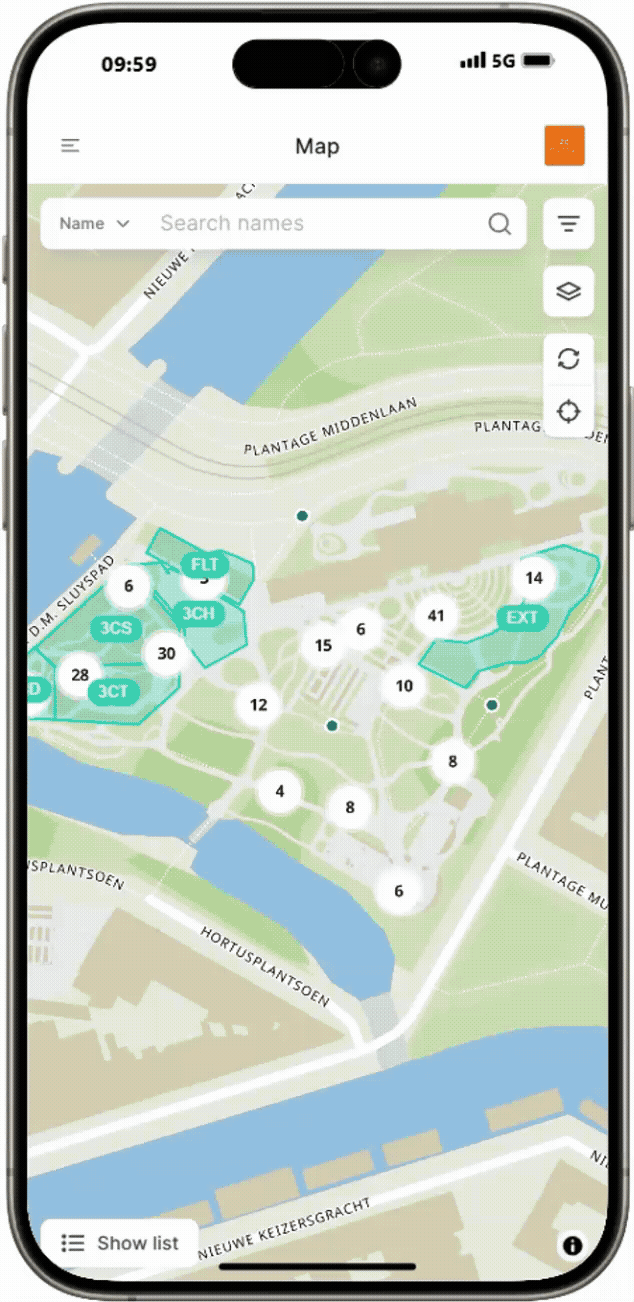A New Era for Zoo Horticulture?


In our recent webinar, we had the pleasure of hosting Suzie Steele from Indianapolis Zoo and Joe Williams from Pittsburgh Zoo & Aquarium for an insightful discussion on the expanding role of botanical records in their institutions. The conversation underscored that accurate plant collection data goes far beyond documentation—it is essential to help streamline internal workflows, enhance visitor engagement, preserve institutional knowledge, and support conservation efforts.
In this article, we’ll highlight the key takeaways that were shared by Suzie and Joe and explore the broader role of horticulture in zoos and aquariums, emphasizing its growing importance in animal care, education, and conservation. We hope these insights may resonate with you if you work with plant collections in a zoo or botanical garden.
🎞️A link to the recording of the webinar is at the end of the article.

Early Zoos and Their Botanical Legacy
Long being seen as institutions promoting a better understanding of the natural world and animal species conservation, the history of zoos is also deeply connected to botany. Early zoological collections, from ancient China’s “Gardens of Intelligence” to “Roman vivaria“, integrated plants to recreate natural habitats. These historical roots set the stage for modern zoos, where botanical knowledge plays a crucial role in animal welfare, conservation, and ecological education.
The transition from private menageries to public zoos in the 18th and 19th centuries solidified the link between botany and zoology. Institutions like the Ménagerie du Jardin des Plantes (Paris, 1793) and London Zoo (1828) were closely tied to botanical gardens, recognizing that plants were essential for habitat simulation, diet, and animal enrichment. Carl Linnaeus, the father of taxonomy, advocated for integrating flora into zoological collections to reflect ecological relationships.

Horticulture at Modern Zoos
Today, leading zoos, such as Indianapolis Zoo and Pittsburgh Zoo & Aquarium, are integrating botanical expertise to support biodiversity in a way that extends beyond aesthetics. Carefully curated landscapes not only enhance animal well-being but also serve as vital educational tools, helping visitors understand ecosystems and conservation. Many zoos now actively manage endangered plant species alongside their animal conservation programs, reinforcing the essential connection between zoology and botany.
As the role of zoos continues to evolve, their botanical legacy remains indispensable. Plants within zoo landscapes are not mere decoration—they provide essential habitat enrichment, support ecological education, and contribute to a holistic conservation strategy.
This perspective is reinforced by a study conducted in the USA, An Analysis of the Role of Horticulture at Zoos: More Than a Place for Animals (Baltzell, 2011), which highlights how horticulture plays a critical role in zoos, supporting both animal welfare and visitor engagement. As part of the research, a survey of 727 zoo employees assessed their organization’s focus on horticulture. The findings revealed that 64% of respondents reported a strong institutional focus on horticulture, while 9% indicated that their organization placed little emphasis on plants.
In 2024, we conducted a similar survey among zoo registrars at the British and Irish Association of Zoos and Aquariums (BIAZA) plant records meeting, with 40 respondents. The results showed an even greater emphasis on horticulture, with 73% reporting that their institution prioritizes plants and only 3% indicating a lack of focus on horticulture.

These surveys indicate that a growing number of zoos are adopting a more holistic approach to biodiversity conservation. As this trend gains momentum, institutions are likely to recognize the critical role of high-quality plant collection data in driving conservation and sustainability initiatives. Modern technology, such as Hortis, opens up new opportunities to accelerate and streamline this transition, making it easier and more enjoyable for institutions to adopt data-driven strategies effectively.

Key Takeaways: Two Stories of Transformation
Outdated, clunky record-keeping systems can slow teams down. That’s why Indianapolis Zoo and Pittsburgh Zoo & Aquarium switched to Hortis, thoughtfully designed with a focus on data accuracy, efficiency, and ease of use.
Why the Switch to Hortis?
- Indianapolis Zoo needed to replace their outdated in-house system, which was slow, unreliable, and lacked mapping and mobile access. As an accredited botanical garden, keeping accurate records was essential.
- Pittsburgh Zoo wanted to better track their diverse 3,000+ plant species and integrate data with animal browse tracking, conservation efforts, and public education. After attending a Hortis webinar and meeting the team, they knew it was the right choice.
Top features they love
- Easy & Intuitive – No steep learning curve. Both teams found it simple to use from day one.
- Faster Data Entry – Saves time compared to older systems.
- Powerful Mapping Tools – Pinpoint plant locations, track browse plants, and visualize collections with satellite imagery.
- Activity Log & Undo Function – Easily track changes, fix mistakes, and collaborate with confidence.
- Mobile-Friendly – Access records in the field via smartphones and tablets, making plant management more efficient.
- Public & Internal Views – Manage both visitor-friendly plant info and detailed staff data in one system.

The benefits for their teams
- More Staff Engagement – Easier access means more team members can use plant records effectively.
- Better Decision-Making – Clean data, mapping, and conservation tracking improves planning.
- Stronger Education & Conservation – Enables visitor-friendly plant databases, QR-coded plant tags, and tracking of endangered species.
- Less Admin, More Horticulture – With faster record-keeping, teams spend more time caring for plants.
Questions and Answers
We had time for a Q&A at the webinar and have included the questions from the session alongside questions we did not have time to answer.
Plant Data & Taxonomy
- How robust is the plant data in Hortis? Does it cover all tropical species?Hortis uses Plants of the World Online as its taxonomic backbone, which includes all the known wild-occurring plant species and over 1.4 million plant names. Users can override or refine data for more detailed local information.
- Does Hortis automatically generate conservation status (IUCN Red List) and plant family names?
Yes! When entering a plant species, Hortis automatically pulls taxonomy and global conservation status, saving time on manual research.
Integration & Mapping
- Can Hortis integrate with irrigation, soil data, and climate records?
While direct integrations aren’t available yet, users can link external resources and maps to Hortis records, including soil maps. Future updates may offer more integration options. - Does Hortis support GIS mapping?
Yes! Hortis offers a fully integrated GIS experience, including mapping plants and the ability to draw bed locations directly in Hortis. Institutions using GIS tools like ArcGIS can incorporate their existing base maps into their workflows. - Can plant photos be used as icons on the map?
Currently, plants are marked with icons, but the team is exploring ways to enhance map visuals, including photo thumbnails or color-coded markers. - Is it easy to transfer data over to Hortis?
Yes. We help all our users get the data over as smoothly as possible.
Features & User Experience
- Would pesticide records in Hortis satisfy state requirements for application records?
This depends on specific state regulations. Hortis allows users to record pesticide treatments, but compliance must be checked on a case-by-case basis. - How easy is it to undo mistakes?
Hortis features an activity log that tracks changes and allows users to revert mistakes or restore deleted records, reducing errors and increasing confidence. - Is Hortis beginner-friendly?
Yes! Users in the webinar praised its intuitive design, making it easy to learn with minimal training. - Can Hortis support public access to plant records?
Yes! Institutions can curate what information is shared publicly, with options like QR code integration for visitor-friendly plant exploration.
Ready to join the community?
Let us know your garden’s requirements, including the number of contributing users.
Learn more from our team of experts
Discuss your data migration needs or any other questions you might have.
Fill in our simple form to request a free trial to explore the benefits of a cloud-based records system.
References
- Blunt, W. (2001). Linnaeus: The Compleat Naturalist. Princeton University Press.
- Elvin, M. (2004). The Retreat of the Elephants: An Environmental History of China. Yale University Press.
- Pliny the Elder (trans. Rackham, H.). (1938). Natural History, Vol. 3. Harvard University Press.
- An Analysis of the Role of Horticulture at Zoos: More Than a Place for Animals (Baltzell, 2011). URI: http://udspace.udel.edu/handle/19716/10116